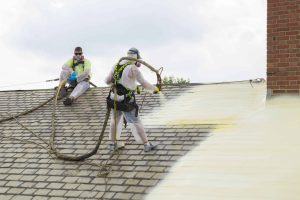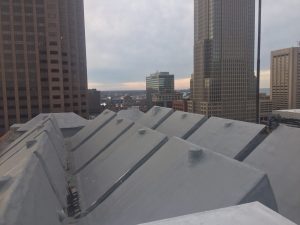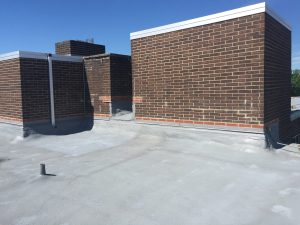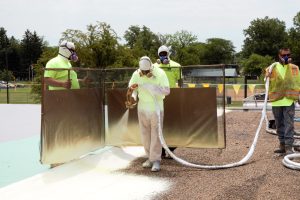Spray Polyurethane Foam Roofing, or spray foam roofing, is a material that is sprayed as a liquid so it can expand into a foam, creating a solid layer across an existing roof. Spray foam roofing can be used to solve your commercial building’s toughest challenges, inside and out.
If you frequent our blog, you know that West Roofing Systems is the expert in Spray Foam Roof installation. We’ve installed over 57,700,000 sq. feet of roofing domestically and internationally and during that time we helped business owners protect their facilities with spray foam.
In this article, we cover everything you need to know when learning about spray foam roofing.
What Is Spray Foam Roofing?

Spray Polyurethane Foam (SPF) is an eco-friendly roofing option for commercial, industrial and manufacturing facilities. Spray Polyurethane Foam, more commonly referred to as SPF, is a material that is sprayed as a liquid, so it can expand into a foam, creating a solid layer across an existing roof.
Read More: Spray Polyurethane Foam (SPF) Roofing: Installation & Performance
While SPF roofing is not the most known type of roofing material, the technology has been around since the early 1960s for industrial, commercial, and residential facilities. An SPF roofing system can be used in any climate, and when correctly installed and maintained, can last over 50 years.
How Much Does Spray Foam Roofing Cost?
For an average 20,000 sq. foot commercial roof, it will usually cost between $4.00 and $7.00 per square foot in materials and labor to install a typical SPF roofing system. This price range is for an SPF roof of average thickness and building structure.
The factors that affect your roof installation cost include:
- The size of your roof
- The thickness of the SPF
- The condition of existing roof
- Silicone coating
- Access to roof
- Type of warranty
- Maintenance
Read More: Cost of an SPF Roof
How Is Spray Foam Roofing Installed?
Before the installation can start, the existing roof (or substrate) needs to be prepared. Rather than stripping the existing roof, the contractor will most likely prepare the substrate by getting rid of all dirt, dust, and contaminants. This can be done with air pressure, vacuuming, or even just sweeping.
The first layer put down by the contractor is the polyurethane foam. This foam is created by combining two liquids (a polyol/resin and an isocyanate) as it’s sprayed onto the existing roof substrate.
As the liquid is sprayed onto the existing roof, it creates a foam that expands 20 times in size to form a solid, seamless foam surface. When the foam has expanded, this layer is usually between 1 and 1.5 inches in thickness. Since the polyurethane foam adheres to most common surfaces, it can be installed on any roof slope.
When the SPF layer has been completed, it is then coated with a layer(s) of elastomeric silicone or acrylic coating with embedded granules. This layer is generally between 20 and 30 mils (a mil is a thousandth of an inch — .001 inch.) in thickness. The coating protects the roof and SPF from UV light, weather, normal wear and provides the required fire ratings.
When the installation is complete, it will create a seamless, durable, moisture-resistant renewable foam roof covering.
What Are the Benefits of Spray Foam Roofing?
 The benefits of installing a spray polyurethane foam (SPF) roofing system, rather than another roof type, are numerous in terms of installation, performance, cost, and longevity.
The benefits of installing a spray polyurethane foam (SPF) roofing system, rather than another roof type, are numerous in terms of installation, performance, cost, and longevity.
Easy Installation
The ease of installation can save you time and money with your new SPF roof. The application of the foam and coating is quick and can be applied with usually no interruption to the daily routine of the facility.
SPF roofs are installed by spraying a liquid on the existing roof and allowing it to expand into a foam. This process means that the foam can conform to all roof shapes and types, even irregularly shaped roofs. After cleaning the existing roof, the SPF roof can be applied directly over asphalt, shingles, concrete, metal, and wood.
Energy Efficient
SPF roofing delivers thermal, air, and moisture barriers to provide the highest R-value per inch, which means the material provides better insulation for the building.
The polyurethane foam keeps heat out in the summer and in during the winter, lowering energy costs for facility owners. The silicone top coating resists UV light, protecting the foam and reduces heat absorption (emissivity).
Easy Maintenance
Once an SPF roof is installed, it requires minimal upkeep. If properly maintained, your SPF roof can last over 50 years. SPF roofing systems should be inspected semi-annually, in the Spring and again in the Fall. Additional inspections are also suggested following any event that might have caused damage to the system.
In the event where a silicone recoating is needed, there’s no tear-off of the existing materials; you apply the new coat on top of the current system.

Seamless and Waterproof
Seams and penetrations are the primary sources of leaks in roof systems, SPF eliminates this vulnerability. Since the SPF mixture is applied as a liquid, it can fill gaps, seams, and cracks in the existing roof and substrate.
The application of the polyurethane foam allows the contractor to level out the roof to decrease the chance of ponding water. The foam material can expand and contract with the building in accordance with outside temperatures, reducing the likelihood of cracks and splitting.
Renewable and Sustainable Roofing
SPF roofs create little to no waste during its lifetime. In most cases, there is minimal stripping of the original roof, and the SPF roof is installed on top – eliminating the need for costly roof tear-offs and waste.
The materials that are used for SPF roofing systems are also environmentally friendly:
- Zero Ozone Depleting Potential (ODP)
- Low in the Emission of Volatile Organic Compounds (VOCs)
- Free from Chlorofluorocarbons (CFCs)
- Ultra-Low Global Warming Potential (GWP)
How Else Can You Use Spray Foam?

Spray foam is a useful material that is not only great for roofing but other uses as well.
Read More: 3 Unique Ways To Use Spray Foam For Your Commercial Building
Building Insulation
Spray foam can be used in residential or commercial facilities as insulation behind walls or ceilings. Open-cell spray foam is mostly used for interior settings and can be applied to areas that need an air barrier. The application is almost identical to spray foam roofing, but there is no need for a silicone top coat.
Ductwork Insulation
With spray foam being utilized on new and existing ductwork, the foam can completely adhere to the duct surface and improve the efficiency of the HVAC equipment.
The benefits of using spray foam on your ductwork include:
- Increase insulation of the ducts
- Reducing air leaks
- Allowing temperature to be maintained inside the duct
- Temperature maintenance outside of the duct
Roof System Tie-Ins
Spray foam can be utilized in an area where two different roof types meet. This area tends to collect substantial amounts of draining water as well as snow drifting. By installing the spray applied product, you create a seamless protective layer prevents any water from backing up under the roof or flashings.
Spray Polyurethane Foam Roofing Systems are becoming the go-to roofing for commercial, industrial, and even residential facilities that are looking for a long-lasting, economically efficient option. From installation and throughout your warranty, the savings of your new SPF can pay off the roof system and save you money down the road.
Original Post Here: Spray Foam Roofing: Everything You Need To Know


No comments:
Post a Comment